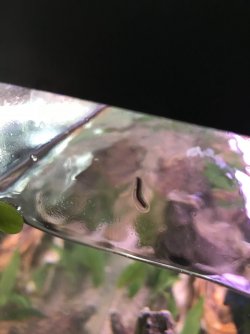In the wild the parasites fall off the fish and settle in the mud on the bottom of the creek or river. As the fish swim around they move to a different section of the river in search of food or new habitat, leaving the parasites behind. When the parasites are released from the cyst several days later, they get washed downstream (if there is flowing water) or they swim around the waterway looking for a new host. If they don't find a new host within 48 hours they die. So unless the parasite can find a new host in a large body of water, within a short period of time, the fish won't be reinfected.First, take a step back. Most fish can deal with ich on their own--after all, if not, ich in nature would have killed off the fish long ago...
Ich is caused by stress, period. Many believe ich is always present in most of our tanks, but it is only severe stress that brings it on...
Compare that to an aquarium with a much smaller volume of water and more fish in close proximity to the newly released parasites. The whitespot parasites have ample opportunity to find and infect any fish in that aquarium. And if left untreated, it will kill every fish in an aquarium by causing scar tissue to the gills and the fish suffocate.
Ichthyopthirius is not caused by stress. It is caused by direct contact with a parasite that has to be introduced into an aquarium by a host fish, or contaminated plants or water. If stress caused Ich, then every quarantine tank would have it. We had 200-2000 fish in each tank in the quarantine room. The fish were overcrowded and lived in all glass tanks with no background picture, gravel, plants or ornaments. They were shipped here in plastic bags containing less than 1 litre of water and the water stank from ammonia when we open the bags. These fish are extremely stressed when we get them but they do not come down with whitespot because it is not in the tanks.
--------------------------
You can use salt if you like but I never bothered using it with heat treatment. It won't hurt the fish at the recommended dose rate but in my experience, it doesn't help kill the parasites either. If you get the salt levels high enough it can kill the parasites but the high dose rates are not tolerated by Cories
Scaleless fishes are not necessarily adversely affected by salt. We have fish in Australia and New Zealand called Galaxias. They are scaleless but several species have a larval stage that lives in the ocean. And Galaxias tolerate salt very well in an aquarium. Stingrays that live in the ocean are scaleless too
The reason Corydoras and some loaches have problems with salt is because they originate in pure freshwater with virtually no mineral content, and certainly no sodium chloride in the water. These fishes have evolved in pure water and have not been exposed to salt in the wild. Subsequently they have smaller kidneys compared to same sized fishes that occur in brackish or seawater. Because of this they are less able to tolerate salt for extended periods. Domestic captive bred Corydoras are more tolerant of salt compared to wild caught Corydoras, but they still have small kidneys and don't tolerate high levels of salt for long periods of time.
------------------------
Salt will not affect the filter cartridge so leave it in the filter
Last edited:




